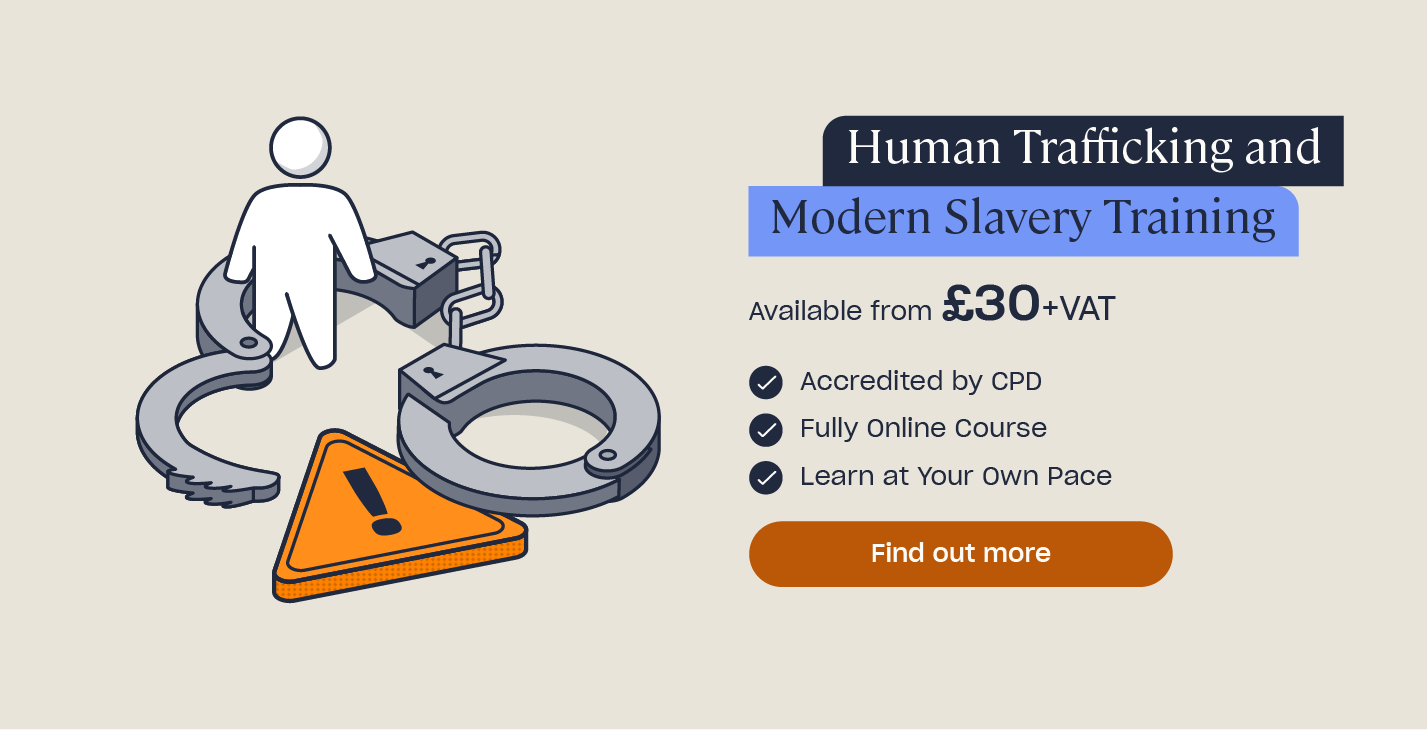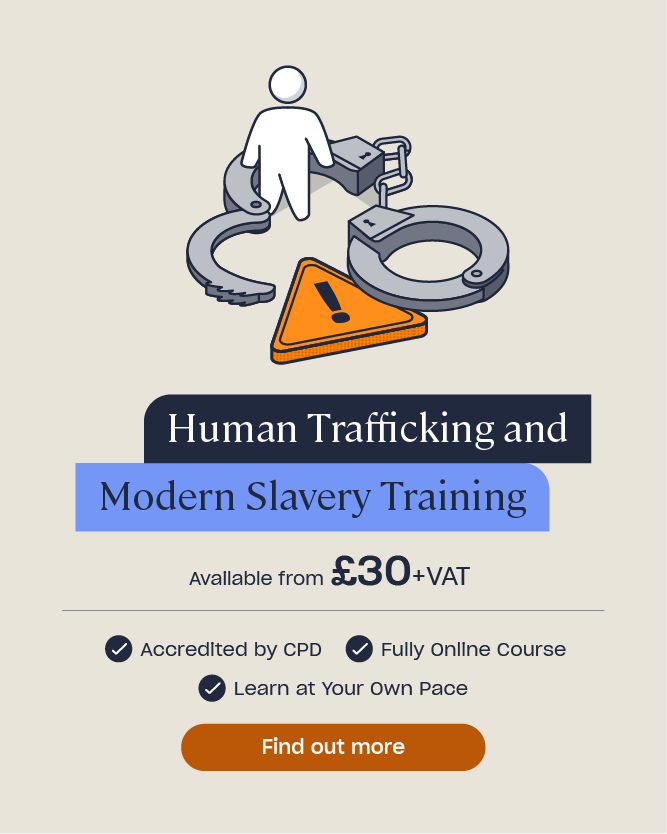What are the Different Types of Modern Slavery?
Though many people believe slavery to be a thing of the past, approximately 50 million people are victims of modern slavery worldwide. Clearly, it is a problem that still exists today – including within the UK. Modern slavery is a serious crime and a violation of human rights. It involves individuals being exploited for someone else’s gain and, unfortunately, there are many different types.
One of the biggest challenges with tackling modern slavery is that, due to its nature, it occurs behind closed doors. The first step, therefore, is raising awareness. While we all have a role to play in preventing modern slavery from continuing, it’s especially important for people who have safeguarding responsibilities, or work in roles that involve safeguarding, to be able to recognise the signs that this may be occuring.
In this article, we will define what modern slavery refers to, explain the different types and the signs to look out for. We’ll also outline what you should do if you suspect modern slavery is occurring.
What is Modern Slavery?
Modern slavery is a crime that involves individuals being forced to work or provide a service for the benefit of others. Though there are many definitions, and it has several forms, they all include aspects of control, involuntary actions and exploitation.
It is important to remember that victims of modern slavery are not just limited to specific groups of people – anyone can be a victim of modern slavery. There are, however, some people who are more at risk of becoming victims of modern slavery than others:
- Children are often viewed as easy targets as they are more susceptible to pressure and persuasion.
- People with learning difficulties may not be able to fully comprehend the situation and therefore are more vulnerable to manipulation.
- People in desperate circumstances – like poverty or debt – are often targeted due to their likelihood of making riskier decisions.
- Asylum seekers can be trapped by their desperation to reach countries like the UK. Traffickers can exploit them by offering them ‘safe’ travel.

As we’ve established, modern slavery can be difficult to detect, due to it generally occurring behind closed doors. This is reflected in how challenging it is to get an accurate measurement of its prevalence across the world. However, it is not just an overseas problem and there is an increasing number of reported incidents in the UK.
In 2021, the UK Annual Report on Modern Slavery found that police recorded 8,730 modern slavery offences across England and Wales, an increase of 5% from the previous year.
Types of Modern Slavery
As modern slavery is a growing concern, it is especially important that people who have safeguarding responsibilities are able to understand the different types. Types of modern slavery include:
- Human trafficking is the illegal movement and trade of people without their consent, often across geographical borders. It often involves the use of threats, violence and coercion in order to use people for forced labour, criminal activity or sexual exploitation. For more information on human trafficking, check out our article, here.
- Sexual exploitation involves forcing victims to perform sexual acts against their will for someone else’s profit.
- Criminal exploitation involves vulnerable individuals – often children – being made to commit crimes like theft, fraud or carrying drugs, often via County Lines.
- Domestic servitude occurs when people are forced to work as domestic helpers under tough conditions and for little or no pay. It is, however, important to note that not all domestic work is classed as slavery and that this is a reliable source of income for many people.
- Forced labour includes any work that individuals are forced to complete against their will. They are often compelled to work long hours, in poor conditions, for little or no pay and usually under threat of punishment.
- Forced marriage occurs when someone is coerced into marriage without giving their consent. Victims of forced marriages cannot leave and often face abuse. Most child marriages are considered a form of modern slavery. For more information, check out our article: What is the Difference between Arranged Marriage and Forced Marriage?.

However, this is not an exhaustive list. Modern Slavery is a web of criminal activity with many strands, and further examples can be found here.
Need a Course?
Our Human Trafficking and Modern Slavery training course provides learners with knowledge of exploitation and trafficking within the UK and teaches you how to identify the signs.
Signs of Modern Slavery
Identifying victims of modern slavery can be challenging for a number of reasons. They are often hidden away by their abusers, or feel unable to tell people about their experiences due to a fear of the potential consequences or shame. Therefore, as someone who works in a safeguarding role, it is crucial that you know the signs and what to look for.
Signs that someone may be a victim of modern slavery include:
- Isolation, fear and withdrawn behaviours.
- Restricted or controlled movement.
- Appearing tired, unwashed or scruffy or showing signs of physical abuse or malnourishment.
- Poor living conditions, such as living in overcrowded or substandard conditions.
- Long work hours.
The signs listed above are indicative that someone may be suffering from abuse in general. For some forms of modern slavery, there are more specific signs to look out for. However, it’s important to remember that experiences and signs will be different for every victim.
Forced Labour
If someone does not have a contract or is paid either less than the minimum wage or nothing at all, then this could be a significant sign that they are being exploited for their labour.
They may lack suitable clothing or protective equipment for the job they are doing, or work unusually long hours in poor conditions. Someone who is a victim of forced labour may show signs of psychological or physical abuse or seem to have a nervous disposition.
Sexual Exploitation
A victim of sexual exploitation may appear scared or withdrawn. They may show signs of physical abuse (for example, bruises, cuts or scars) or emotional abuse (they may appear to have low self-esteem or self-worth).
Someone living and working at the same address can be an indication that a brothel is operating from that address.

Domestic Servitude
If someone is held in their employer’s home and is unable to leave on their own or their movements are restricted, this could be a sign that they are a victim of domestic servitude.
Look out for signs such as working unusually long hours or being denied access to their own living space or possessions, including items like their ID or phone.
Criminal Exploitation
Signs of criminal exploitation often include suspicious or secretive behaviour and the appearance of unexplained money or items. Someone who is a victim of criminal exploitation may become withdrawn and preoccupied with phone calls and texts.
What to Do if you Suspect Modern Slavery
Modern slavery is a serious crime and we all have a role to play in preventing it. If you suspect modern slavery is occurring, it is crucial that you inform someone as soon as it is safe to do so. Do not assume that someone else will raise the concern; you must speak out, as your information could save a life.
You can:
- Report it to the Modern Slavery Helpline on 08000 121 700.
- Make an anonymous report on the Crimestoppers website or call them on 0800 555 111.
- Contact the police on 101 for non-emergency enquiries or use the textphone service on 18001 101 if you have a speech or hearing impairment.
- Call 999 if you suspect that someone is in immediate danger.
Remember that you do not have to be certain of your concern to make a report and you will always be taken seriously.
We hope you’ve found this article on modern slavery informative and helpful. If you have any further questions about the topics discussed in this article, don’t hesitate to get in touch with us at High Speed Training. You can contact our friendly team on 0333 006 7000 or email support@highspeedtraining.co.uk.
Further Resources:
- Human Trafficking and Modern Slavery Training
- Methods of Human Trafficking and Recruitment
- Writing a Modern Slavery Policy: Guidance for Employers
- How Can We Work Together to Safeguard Adults?











